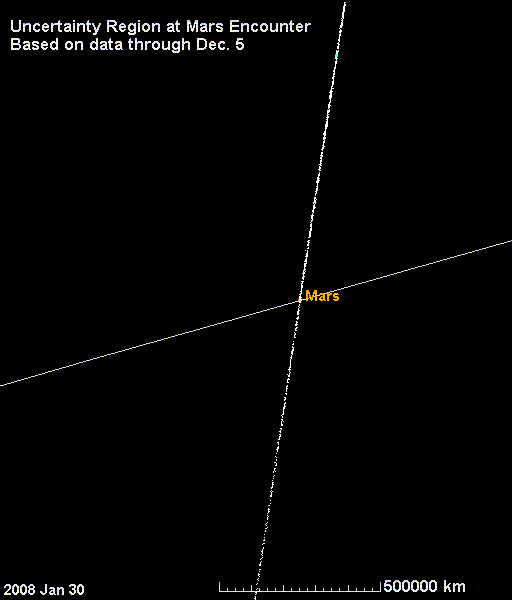Emily Lakdawalla • Jan 10, 2008
Mars impact chance drops to 1 in 10,000, which may as well be zero
1 in 10,000 is still better than your chance of winning a lottery, but it's very, very unlikely. The newly discovered Earth-crossing asteroid 2007 WD5 has been generating a lot of excitement because at one point it had as high as a 1 in 25 chance of hitting Mars, but according to the Near Earth Object program the latest observations of the asteroid's path have "led to a significant reduction in the position uncertainties during the asteroid's close approach to Mars on January 30, 2008....Our best estimate now is that 2007 WD5 will pass about 26,000 kilometers from the planet's center (about seven Mars radii from the surface) at around 12:00 UTC (4:00 am PST) on January 30. With 99.7% confidence, the pass should be no closer than 4,000 kilometers from the surface."
They also posted an animation that neatly shows how the uncertainty in the position of WD5 has decreased over time:

NASA / JPL
Shrinking uncertainty surrounding 2007 WD5's close flyby of Mars
In early December 2007, astronomers realized that newly discovered Earth-crossing asteroid 2007 WD5 would have an extremely close encounter with Mars on Jauary 30, 2008. Initially, the uncertainty in its position translated into a large uncertainty in where it would actually approach closest to Mars. In the diagrams in this animation, the stippled white band from lower left to upper right represents a long, skinny ellipse of possible positions for WD5 during its closest approach. Throughout December, as more observations of WD5 decreased the uncertainty in its position, the ellipse shrank, but it continued to intersect Mars, with the result that the likelihood of an impact steadily increased. By early January, however, the uncertainty (and the ellipse representing the possible position of WD5 during its closest approach) had decreased enough that there was no longer a significant chance of WD5 striking Mars.- 2007 WD5 was discovered using the Mt. Lemmon 1.5-meter telescope by Andrea Boattini of the University of Arizona's Catalina Sky Survey, which is led by Steve Larson.
- Follow-up from archival images taken by the 1.8-meter telescope on Kitt Peak in Arizona were provided by Terrence H. Bressi of the University of Arizona's Spacewatch Project, which is led by Robert McMillan.
- Andy Puckett of the Univ. of Alaska obtained pre-discovery measurements from archival images of the Sloan Digital Sky Survey's 2.5-meter telescope on Apache Point, NM.
- Bill Ryan of New Mexico Tech's Magdalena Ridge Observatory observed 2007 WD5 on several crucial nights, with critical support from university and observatory staff.
- Observations from the 6.5-meter Multi-Mirror Telescope (MMT) Observatory in Arizona were provided by a team consisting of Holger Israel (Univ. Bonn), Matt Holman (Harvard/CfA), Steve Larson (Univ. Ariz.), Faith Vilas (MMTO), Cesar Fuentes (Harvard/CfA), David Trilling (Univ. Ariz.) and Maureen Conroy (Harvard/CfA).
- The 3.5-meter telescope at the Calar Alto Observatory in Spain provided follow-up through a team consisting of Adriano Campo Bagatin (Univ. Alicante), Gilles Bergond (Calar Alto Obs.), Rene Duffard (Inst. de Astrofisica de Andalucia), Jose Luis Ortiz (Inst. de Astrofisica de Andalucia), Reiner Stoss (Obs. Astronomico de Mallorca and Astronomisches Rechen-Institut) and Javier Licandro (Inst. de Astrofisica de Canarias).
- Fabrizio Bernardi, Marco Micheli and Dave Tholen of the Univ. of Hawaii Institute for Astronomy observed the asteroid at its faintest using the 2.2-meter UH telescope on Mauna Kea in Hawaii.
We just cancelled any potential observations of 2007 WD5, given the odds of impacting the surface of Mars. It is a pity, as Mars Express was the best positioned Mars orbiter to observe this asteroid. To study the trajectory is less exciting. I very much regret this turn of events, as it would have been very exciting to monitor an impact on Mars almost in real time and in particular to study its aftermath. Let's hope for another chance.
I haven't heard back yet from the Mars Reconnaissance Orbiter folks but I'll let you know if I do.
(Here are my past posts on WD5: December 21, with chances at 1 in 75; December 27, at 1 in 25; January 2, at 1 in 28; January 8, at 1 in 40; January 10, at 1 in 10,000.)
Support our core enterprises
Your support powers our mission to explore worlds, find life, and defend Earth. You make all the difference when you make a gift. Give today!
Donate

 Explore Worlds
Explore Worlds Find Life
Find Life Defend Earth
Defend Earth

